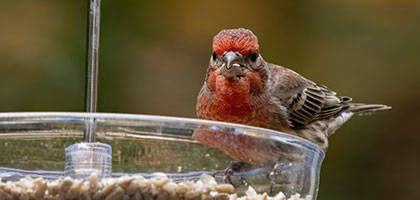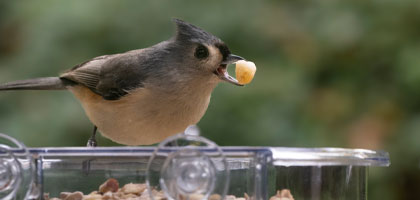Blue jays are a captivating sight in any backyard. Their vibrant plumage and lively behavior make them a favorite among bird watchers and nature enthusiasts.
But how do you attract these beautiful birds to your garden? The answer lies in understanding their feeding habits and preferences.
Blue jays are particularly fond of peanuts, sunflower seeds, and suet. Providing these in a suitable feeder can make your backyard a popular spot for these birds.
However, not all bird feeders are created equal. Blue jays, with their larger size and boisterous nature, require specific types of feeders.
This guide will delve into the best types of bird feeders for blue jays. We'll explore various options, their benefits, and how to use them effectively.
So, whether you're a seasoned bird watcher or a beginner looking to attract blue jays, this guide will provide the information you need. Let's get started.
Understanding Blue Jay Feeding Preferences
Blue jays are intelligent birds with distinct feeding preferences. They tend to favor specific types of food, which influences the feeder choice. By understanding these preferences, you can more effectively attract blue jays to your garden.
Here's a quick list of their favorite foods:
- Peanuts, especially whole peanuts in the shell
- Sunflower seeds, particularly black oil variety
- Suet cakes, especially during colder months
Blue jays also appreciate feeders that provide ample perching space. This is due to their larger size compared to other common backyard birds. Their instinctual need to cache food means they often visit feeders multiple times a day, making food variety crucial.
Best Types of Feeders for Blue Jays
Choosing the right feeder is essential to attract blue jays successfully. There are several styles that cater to their feeding habits and dietary preferences. By selecting appropriate feeders, you can enhance your bird-watching experience.
Here is a list of feeder types ideal for blue jays:
- Platform feeders
- Hopper feeders
- Blue jay peanut bird feeders
Each type has unique benefits tailored to meet the needs of blue jays. Ensuring you have a selection of these feeders in your yard can maximize the chance of attracting these vibrant birds. It also allows you to cater to different feeding preferences depending on the season. The durability of the feeder should be a priority, as blue jays can be quite robust and active. A sturdy feeder ensures longevity and a consistent food source.
Platform Feeders
Platform feeders are flat, tray-like structures that provide ample space. These feeders are excellent for blue jays, accommodating their larger size.
Due to their open design, platform feeders allow easy access to food. This makes it simple for blue jays to pick up peanuts and seeds. They also enable feeding from different angles, accommodating multiple birds simultaneously.
Hopper Feeders
Hopper feeders are another great option for blue jays. They often resemble small houses or barns and offer shelter for the food.
These feeders have a capacity for a mix of seeds, attracting various bird species. Their design includes perches and a large dispensing area. This makes it easy for blue jays to access food and feel comfortable while feeding.
Blue Jay Peanut Bird Feeders
Peanut bird feeders are specifically designed to dispense whole peanuts. Blue jays are especially fond of peanuts, making this an ideal choice.
These feeders often feature mesh wire designs that hold the peanuts in place. They encourage blue jays to use their strong beaks to retrieve peanuts, engaging their natural feeding behavior. With peanuts being a high-energy food, these feeders are particularly beneficial during colder seasons.
Feeder Placement and Safety
Proper placement of your bird feeders is crucial for attracting blue jays. It also plays a role in ensuring their safety while they feed. By choosing the right spot, you enhance the chances of frequent visits.
Here are some tips for placing bird feeders:
- Place feeders 10-12 feet off the ground
- Avoid areas too close to predators or hiding spots
- Ensure clear visibility for birds' comfort
Consider the overall environment and any potential threats. Open spaces offer a safer feeding area but ensure some nearby cover for shelter. Balancing these factors encourages a thriving bird feeding station.
Positioning Your Feeder
Place your feeders at least 10-12 feet above the ground. This height prevents predators like cats from reaching the birds. It also encourages blue jays to visit more frequently.
Ensure feeders are visible from open areas, making birds feel secure. Avoid areas near large windows to prevent collisions. Positioning your feeders properly maximizes both safety and feeding opportunities for blue jays.
Protecting Blue Jays from Predators
Safeguarding blue jays from predators is essential for a successful feeding station. Utilize baffles or barriers to deter squirrels and other larger animals.
Select spots where blue jays can easily escape if needed. Avoid areas with dense cover that could hide potential dangers. By maintaining a secure environment, blue jays will feel more at ease visiting the feeders frequently.
Maintaining a Healthy Feeding Station
Keeping your bird feeding station clean ensures the health of the visiting blue jays. Regular maintenance prevents the spread of diseases and keeps the area inviting. By following some simple practices, you can maintain a thriving bird haven.
Consider these maintenance tips:
- Clean feeders weekly or biweekly with soap and water
- Remove old food or debris from the ground
- Use no-waste food options to minimize mess
- Monitor for signs of disease among visiting birds
A well-maintained feeding station promotes blue jays' wellbeing and encourages diverse bird species to visit.
Cleaning and Hygiene
Maintaining hygiene is vital in bird feeding. Wash feeders weekly with warm, soapy water to remove harmful bacteria. Rinse and dry thoroughly before refilling them with food.
Ensure that the surrounding area is also clean and free of droppings. This practice keeps your station safe and encourages more blue jays to visit. Prioritizing cleanliness extends the life of your feeders and supports bird health.
Dealing with Feeder Pests
Pests can interfere with your bird feeding efforts. To deter them, consider using weight-sensitive perches that only allow birds to feed. These prevent heavier animals, like squirrels, from gaining access.
Implementing baffles or barriers can also keep pests away from feeders. Regularly check for signs of unwanted visitors and adjust your strategies accordingly. Keeping pests at bay ensures that your blue jays have uninterrupted access to the feeders.
Additional Tips for Attracting Blue Jays
Attracting blue jays can be a delightful experience for any bird enthusiast. By enhancing your feeder setup and surrounding environment, you can make it irresistible to these vibrant birds. Following a few effective strategies can increase your chances of seeing blue jays frequently.
Consider the following tips:
- Provide diverse food options like suet, peanuts, and sunflower seeds
- Ensure fresh water is always available
- Place feeders at various heights to cater to different feeding preferences
- Install natural perches to give birds resting spots
Implementing these tips helps create an inviting space for blue jays.
Offering a Variety of Foods
Diversifying the food you offer can attract blue jays more effectively. Peanuts, either shelled or unshelled, are a favorite. Sunflower seeds and suet provide necessary nutrients and energy.
Rotate different food options to keep the blue jays returning to your feeders. Mixing up what you offer also deters monotony, enticing them with a variety of tasty choices.
Creating a Bird-Friendly Habitat
A bird-friendly habitat goes beyond just feeders. Incorporate natural elements like trees and shrubs for shelter and nesting. These provide safety and enhance the appeal of your yard.
Offer a water source like a bird bath to meet their drinking and bathing needs. Keeping the area quiet and undisturbed ensures a peaceful setting for blue jays and increases your chances of them staying longer.
Conclusion: Enjoying Your Blue Jay Visitors
Observing blue jays in your yard can be a rewarding experience. By choosing the right feeders and providing a welcoming environment, you attract these fascinating birds. Appreciate their vibrant colors and behaviors as you relax and enjoy their company. Happy bird-watching!




